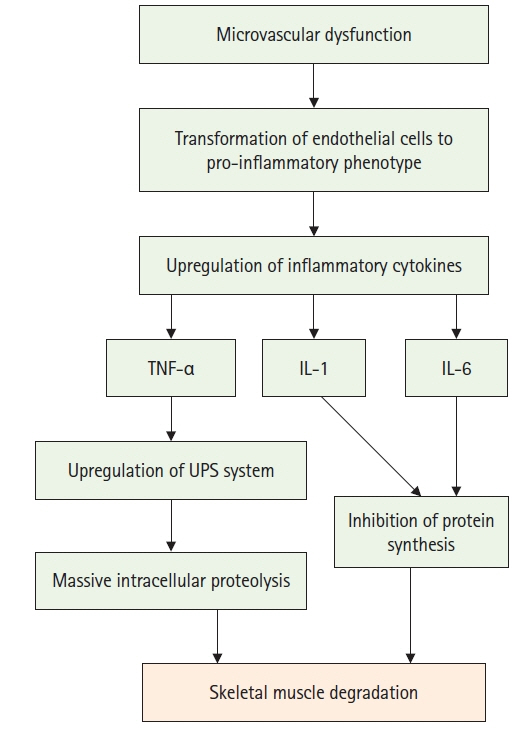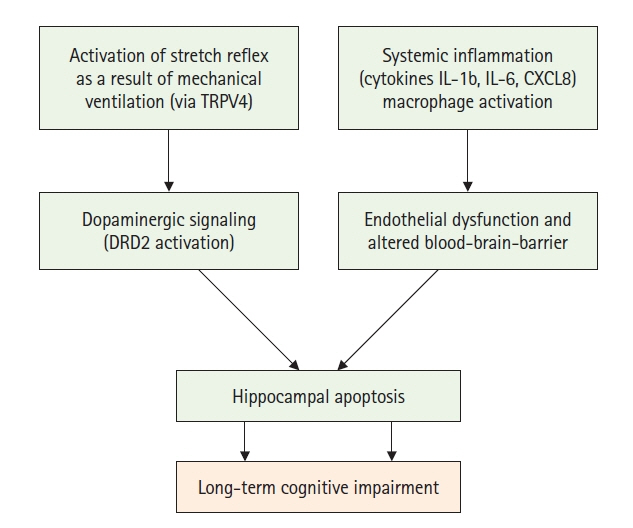Acute Crit Care.
2024 May;39(2):226-233. 10.4266/acc.2023.01158.
Beyond survival: understanding post-intensive care syndrome
- Affiliations
-
- 1Maulana Azad Medical College, New Delhi, India
- 2Sri Ramachandra Institute of Higher Education and Research, Chennai, India
- 3Shri Ram Murti Smarak Institute of Medical Sciences, Bareilly, India
- 4Howard County Center for Lung and Sleep Medicine, Columbia, MD, USA
- 5Internal Medicine, Dayanand Medical College and Hospital, Ludhiana, India
- 6Department of Internal Medicine, Cleveland Clinic Akron General, Akron, OH, USA
- 7Penn State Milton S. Hershey Medical Center, Hershey, PA, USA
- KMID: 2557238
- DOI: http://doi.org/10.4266/acc.2023.01158
Abstract
- Post-intensive care syndrome (PICS) refers to persistent or new onset physical, mental, and neurocognitive complications that can occur following a stay in the intensive care unit. PICS encompasses muscle weakness; neuropathy; cognitive deficits including memory, executive, and attention impairments; post-traumatic stress disorder; and other mood disorders. PICS can last long after hospital admission and can cause significant physical, emotional, and financial stress for patients and their families. Several modifiable risk factors, such as duration of sepsis, delirium, and mechanical ventilation, are associated with PICS. However, due to limited awareness about PICS, these factors are often overlooked. The objective of this paper is to highlight the pathophysiology, clinical features, diagnostic methods, and available preventive and treatment options for PICS.
Keyword
Figure
Reference
-
1. Inoue S, Hatakeyama J, Kondo Y, Hifumi T, Sakuramoto H, Kawasaki T, et al. Post-intensive care syndrome: its pathophysiology, prevention, and future directions. Acute Med Surg. 2019; 6:233–46.
Article2. Yanagi N, Kamiya K, Hamazaki N, Matsuzawa R, Nozaki K, Ichikawa T, et al. Post-intensive care syndrome as a predictor of mortality in patients with critical illness: a cohort study. PLoS One. 2021; 16:e0244564.
Article3. Smith S, Rahman O. Postintensive care syndrome [Internet]. StatPearls Publishing;2023. [cited 2023 Dec 1]. Available from: https://pubmed.ncbi.nlm.nih.gov/32644390/.4. LaBuzetta JN, Rosand J, Vranceanu AM. Review: post-intensive care syndrome: unique challenges in the neurointensive care unit. Neurocrit Care. 2019; 31:534–45.
Article5. Renner C, Jeitziner MM, Albert M, Brinkmann S, Diserens K, Dzialowski I, et al. Guideline on multimodal rehabilitation for patients with post-intensive care syndrome. Crit Care. 2023; 27:301.
Article6. Hiser SL, Fatima A, Ali M, Needham DM. Post-intensive care syndrome (PICS): recent updates. J Intensive Care. 2023; 11:23.
Article7. Marra A, Pandharipande PP, Girard TD, Patel MB, Hughes CG, Jackson JC, et al. Co-occurrence of post-intensive care syndrome problems among 406 survivors of critical illness. Crit Care Med. 2018; 46:1393–401.
Article8. Righy C, Rosa RG, da Silva RT, Kochhann R, Migliavaca CB, Robinson CC, et al. Prevalence of post-traumatic stress disorder symptoms in adult critical care survivors: a systematic review and meta-analysis. Crit Care. 2019; 23:213.
Article9. Weidman K, LaFond E, Hoffman KL, Goyal P, Parkhurst CN, Derry-Vick H, et al. Post-intensive care unit syndrome in a cohort of COVID-19 survivors in New York City. Ann Am Thorac Soc. 2022; 19:1158–68.
Article10. Unoki T, Sakuramoto H, Uemura S, Tsujimoto T, Yamaguchi T, Shiba Y, et al. Prevalence of and risk factors for post-intensive care syndrome: multicenter study of patients living at home after treatment in 12 Japanese intensive care units, SMAP-HoPe study. PLoS One. 2021; 16:e0252167.
Article11. Nalbandian A, Sehgal K, Gupta A, Madhavan MV, McGroder C, Stevens JS, et al. Post-acute COVID-19 syndrome. Nat Med. 2021; 27:601–15.
Article12. Halpin SJ, McIvor C, Whyatt G, Adams A, Harvey O, McLean L, et al. Postdischarge symptoms and rehabilitation needs in survivors of COVID-19 infection: a cross-sectional evaluation. J Med Virol. 2021; 93:1013–22.
Article13. Mulkey MA, Beacham P, McCormick MA, Everhart DE, Khan B. Minimizing post-intensive care syndrome to improve outcomes for intensive care unit survivors. Crit Care Nurse. 2022; 42:68–73.
Article14. Kress JP, Hall JB. ICU-acquired weakness and recovery from critical illness. N Engl J Med. 2014; 370:1626–35.
Article15. Mendelson AA, Erickson D, Villar R. The role of the microcirculation and integrative cardiovascular physiology in the pathogenesis of ICU-acquired weakness. Front Physiol. 2023; 14:1170429.
Article16. Martín-Vicente P, López-Martínez C, Lopez-Alonso I, López-Aguilar J, Albaiceta GM, Amado-Rodríguez L. Molecular mechanisms of postintensive care syndrome. Intensive Care Med Exp. 2021; 9:58.
Article17. Lad H, Saumur TM, Herridge MS, Dos Santos CC, Mathur S, Batt J, et al. Intensive care unit-acquired weakness: not just another muscle atrophying condition. Int J Mol Sci. 2020; 21:7840.
Article18. Dos Santos C, Hussain SN, Mathur S, Picard M, Herridge M, Correa J, et al. Mechanisms of chronic muscle wasting and dysfunction after an intensive care unit stay: a pilot study. Am J Respir Crit Care Med. 2016; 194:821–30.
Article19. Voiriot G, Oualha M, Pierre A, Salmon-Gandonnière C, Gaudet A, Jouan Y, et al. Chronic critical illness and post-intensive care syndrome: from pathophysiology to clinical challenges. Ann Intensive Care. 2022; 12:58.
Article20. González-López A, López-Alonso I, Aguirre A, Amado-Rodríguez L, Batalla-Solís E, Astudillo A, et al. Mechanical ventilation triggers hippocampal apoptosis by vagal and dopaminergic pathways. Am J Respir Crit Care Med. 2013; 188:693–702.
Article21. Hughes CG, Morandi A, Girard TD, Riedel B, Thompson JL, Shintani AK, et al. Association between endothelial dysfunction and acute brain dysfunction during critical illness. Anesthesiology. 2013; 118:631–9.
Article22. Sekino N, Selim M, Shehadah A. Sepsis-associated brain injury: underlying mechanisms and potential therapeutic strategies for acute and long-term cognitive impairments. J Neuroinflammation. 2022; 19:101.
Article23. Tokuda R, Nakamura K, Takatani Y, Tanaka C, Kondo Y, Ohbe H, et al. Sepsis-associated delirium: a narrative review. J Clin Med. 2023; 12:1273.
Article24. Ramnarain D, Pouwels S, Fernández-Gonzalo S, Navarra-Ventura G, Balanzá-Martínez V. Delirium-related psychiatric and neurocognitive impairment and the association with post-intensive care syndrome: a narrative review. Acta Psychiatr Scand. 2023; 147:460–74.
Article25. Wang S, Meeker JW, Perkins AJ, Gao S, Khan SH, Sigua NL, et al. Psychiatric symptoms and their association with sleep disturbances in intensive care unit survivors. Int J Gen Med. 2019; 12:125–30.26. Howard AF, Currie L, Bungay V, Meloche M, McDermid R, Crowe S, et al. Health solutions to improve post-intensive care outcomes: a realist review protocol. Syst Rev. 2019; 8:11.
Article27. Wang S, Allen D, Kheir YN, Campbell N, Khan B. Aging and post-intensive care syndrome: a critical need for geriatric psychiatry. Am J Geriatr Psychiatry. 2018; 26:212–21.
Article28. Sevin CM, Bloom SL, Jackson JC, Wang L, Ely EW, Stollings JL. Comprehensive care of ICU survivors: development and implementation of an ICU recovery center. J Crit Care. 2018; 46:141–8.
Article29. Mikkelsen ME, Still M, Anderson BJ, Bienvenu OJ, Brodsky MB, Brummel N, et al. Society of Critical Care Medicine’s International Consensus Conference on prediction and identification of long-term impairments after critical illness. Crit Care Med. 2020; 48:1670–9.
Article30. Ahmad MH, Teo SP. Post-intensive care syndrome. Ann Geriatr Med Res. 2021; 25:72–8.
Article31. Prescott HC, Angus DC. Enhancing recovery from sepsis: a review. JAMA. 2018; 319:62–75.32. Evans L, Rhodes A, Alhazzani W, Antonelli M, Coopersmith CM, French C, et al. Executive Summary: Surviving Sepsis Campaign: international guidelines for the management of sepsis and septic shock 2021. Crit Care Med. 2021; 49:1974–82.33. Ely EW. The ABCDEF bundle: science and philosophy of how ICU liberation serves patients and families. Crit Care Med. 2017; 45:321–30.
Article34. Rawal G, Yadav S, Kumar R. Post-intensive care syndrome: an overview. J Transl Int Med. 2017; 5:90–2.
Article35. Garrouste-Orgeas M, Coquet I, Périer A, Timsit JF, Pochard F, Lancrin F, et al. Impact of an intensive care unit diary on psychological distress in patients and relatives. Crit Care Med. 2012; 40:2033–40.
Article36. Bryant SE, McNabb K. Postintensive care syndrome. Crit Care Nurs Clin North Am. 2019; 31:507–16.
Article37. McIntosh TK, Juhler M, Wieloch T. Novel pharmacologic strategies in the treatment of experimental traumatic brain injury: 1998. J Neurotrauma. 1998; 15:731–69.
Article38. Shuaib A, Lees KR, Lyden P, Grotta J, Davalos A, Davis SM, et al. NXY-059 for the treatment of acute ischemic stroke. N Engl J Med. 2007; 357:562–71.
Article39. Panahi Y, Mojtahedzadeh M, Najafi A, Rajaee SM, Torkaman M, Sahebkar A. Neuroprotective agents in the intensive care unit: neuroprotective agents in ICU. J Pharmacopuncture. 2018; 21:226–40.40. Hurtado O, Hernández-Jiménez M, Zarruk JG, Cuartero MI, Ballesteros I, Camarero G, et al. Citicoline (CDP-choline) increases Sirtuin1 expression concomitant to neuroprotection in experimental stroke. J Neurochem. 2013; 126:819–26.
- Full Text Links
- Actions
-
Cited
- CITED
-
- Close
- Share
- Similar articles
-
- Post–intensive-care morbidity among pediatric patients in Thailand: prevalence, risk factors, and the importance of the post–intensive-care clinic
- Cut-Off Values of the Post-Intensive Care Syndrome Questionnaire for the Screening of Unplanned Hospital Readmission within One Year
- Management of post-cardiac arrest syndrome
- Prevalence and Risk Factors of Anxiety, Depression, and Post-Traumatic Stress Disorder in Critical Care Survivors
- Nurses Attitudes toward Death, Coping with Death and Understanding and Performance Regarding EOL Care: Focus on Nurses at ED, ICU and Oncology Department




